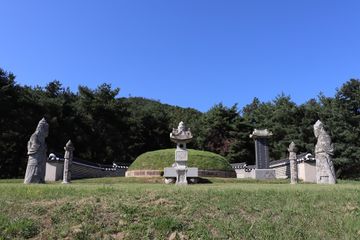전계대원군 묘 및 신도비
| 전계대원군 묘 및 신도비 Tomb and Stele of Grand Prince Yi Gwang |
|
 경기도민기자단, 전계대원군 묘 및 신도비, 경기도 공식 블로그, 네이버 블로그. |
|
| 대표명칭 | 전계대원군 묘 및 신도비 |
|---|---|
| 영문명칭 | Tomb and Stele of Grand Prince Yi Gwang |
| 한자 | 全溪大院君 墓 및 神道碑 |
| 주소 | 경기도 포천시 삼육사로2105번길 22(선단동 773) |
| 지정(등록) 종목 | 포천시 향토유적 제1호 |
| 지정(등록)일 | 1986년 4월 9일 |
| 소유자 | 사유 |
|
|
|
해설문
국문
전계대원군 이광(李, 1785~1841)과 부인 전주 최씨의 합장묘와 신도비이다.
전계대원군은 조선 영조(1724~1776 재위)의 증손이고 철종(1849~1863 재위)의 아버지다. 정조 10년(1786) 아버지인 은언군 이인(恩彦君 李䄄, 1754~1801)이 역모 사건에 연루된 후 강화도에 유배되어 그곳에서 자랐다. 왕족이지만 일반민과 다름없는 생활을 했으며, 늦은 나이에 최수창의 딸과 혼인하여 회평군과 원평군을 낳았다. 후에 철종이 되는 셋째 아들 원범은 후처(염성화의 딸) 소생이다. 원범의 즉위 후에 대원군으로 추봉되었다.
처음에는 양주군 신혈면 진관(지금의 서울 은평구 진관동)에 안장되었다가, 철종 7년(1856)에 이곳으로 이장하였다. 묘는 봉분 하단에 호석을 둘렀고, 묘비와 상석·향로석·장명등·망주석·무인석을 갖추고 있으며, 무덤 주위로 나지막한 담인 곡장을 쌓았다. 묘비는 철종 7년(1856)에 세운 것으로, 앞면에 완양부대부인 전주최씨가 함께 묻혔다는 어필을 새겼다. 신도비는 철종 2년(1851)에 건립되었으며, 비문은 왕명으로 조두순(趙斗淳, 1796~1870)이 지었다.
영문
Tomb and Stele of Grand Prince Yi Gwang
This is the tomb and stele of Yi Gwang (1785-1841) and his wife Lady Choe. Yi Gwang was the great-grandson of King Yeongjo (r. 1724-1776) and the father of King Cheoljong (r. 1849-1863) of the Joseon dynasty (1392-1910). Yi grew up on Ganghwado Island because his father, Yi In (1754-1801), was accused of being involved in a conspiracy against King Jeongjo (r. 1776-1800) in 1786, and was thus sent to exile on the island. Despite being a member of the royal family, he led a life not different from ordinary people. He married Lady Choe at a comparatively late age and had two sons. He also had a concubine, Lady Yeom, by whom his third son was born, who was later enthroned as King Cheoljong. Upon his son becoming king, Yi Gwang was bestowed the title of Grand Prince Jeongye.
The tomb of Yi Gwang was originally located in today’s Eunpyeong-gu, Seoul but was relocated to its current place in 1856. A tombstone erected at that time states that he and his first wife are buried together in a single tomb mound. The tombstone’s inscription was personally calligraphed by King Cheoljong. The tomb mound is lined at the base with square stones, and a low semi-circular stone wall stands behind it. There is also a stone table, stone incense table, stone lantern, stone pillars, and stone statues of military officials in front of the tomb mound. The stele was erected in 1851, and the epitaph was composed by the civil official Jo Du-sun (1796-1870) upon royal command.